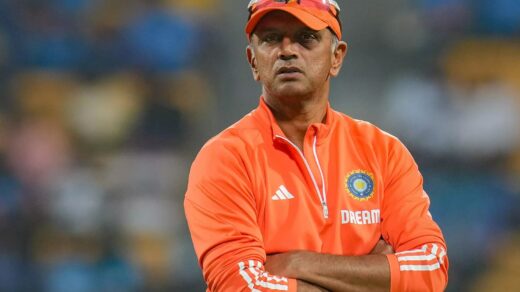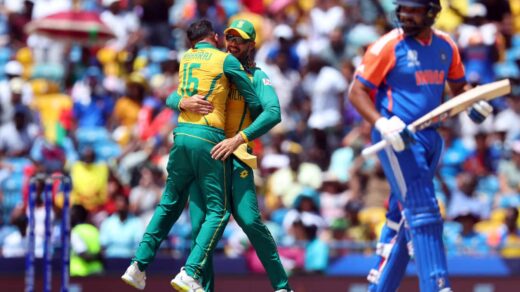Cricket history is filled with memorable moments, but few decisions have shaped the game’s future quite like the first-ever third umpire dismissal.
This groundbreaking moment occurred on November 14, 1992, during a Test match in Durban, South Africa, forever changing how cricket handles close calls and controversial decisions.
What started as a single run-out appeal became the catalyst for technology’s permanent role in the sport.
The player at the center of this historic moment was none other than Sachin Tendulkar, India’s young batting prodigy who would go on to become one of cricket’s greatest legends.
Who Was The First Player To Be Given Out By The Third Umpire?

His dismissal marked the beginning of an era where television replays and technological assistance would help umpires make more accurate decisions, leading eventually to the sophisticated Decision Review System we see today.
Also Check: Most Handsome Cricketer in The World
What Was the Match Where This Historic Decision Happened?
The historic moment took place during the first Test match between India and South Africa at Kingsmead Stadium in Durban, played from November 13-17, 1992.
This series was particularly significant because South Africa had only recently been readmitted to international cricket after decades of isolation due to apartheid.
The cricketing world was watching closely to see how the Proteas would perform against established teams, and India provided strong opposition for this highly anticipated contest.
The match itself was played in typical Test match fashion, with both teams battling hard for advantage. South Africa batted first and were dismissed for 254 runs, setting a competitive total.
India responded strongly in their first innings, eventually reaching 277 and taking a small but important first-innings lead.
However, rain interrupted play significantly on the third and fourth days, ultimately leading to the match being drawn.
South Africa had reached 176 for 3 wickets in their second innings when time ran out.
Despite the inconclusive result on the scorecard, this Test match will forever be remembered not for the cricket played but for the technological breakthrough that occurred during India’s first innings. Here’s how the match scorecard looked:
| Innings | Team | Score | Result |
|---|---|---|---|
| 1st Innings | South Africa | 254 All Out | Match Drawn |
| 1st Innings | India | 277 All Out | Match Drawn |
| 2nd Innings | South Africa | 176/3 | Match Drawn |
| 2nd Innings | India | Did Not Bat | Match Drawn |
Also Check: IPL Winning Captains List 2008 to 2025
How Did the Run-Out Happen?
During India’s first innings response to South Africa’s 254, Sachin Tendulkar was batting and looking to rotate the strike.
He pushed a delivery into the leg side and immediately called for what appeared to be a comfortable single.
His eyes were focused on completing the run quickly, but he hadn’t fully accounted for one crucial factor—the presence of Jonty Rhodes in the field.
Rhodes, who was already establishing his reputation as one of cricket’s most brilliant fielders, was positioned at mid-wicket.
He swooped in with exceptional speed, gathered the ball cleanly, and released a lightning-fast throw directly at the stumps.
The throw was pinpoint accurate, crashing into the wickets while Tendulkar was still scrambling to make his ground.
The call was incredibly close—too close for the on-field umpire to make with absolute certainty using his eyes alone.
In a groundbreaking decision, the umpire signaled to refer the matter to the third umpire, Karl Liebenberg, who was stationed off the field with access to television replays.
Timeline of the Historic Run-Out:
- Tendulkar pushes the ball into the leg side and calls for a single
- Jonty Rhodes charges in from mid-wicket position
- Rhodes gathers the ball and releases a direct throw at the stumps
- The ball hits the stumps while Tendulkar is scrambling to reach the crease
- On-field umpire deems the call too close to judge with certainty
- The decision is referred to the third umpire, Karl Liebenberg for the first time in cricket history
- Liebenberg reviews multiple camera angles and slow-motion replays
- Replays confirm Tendulkar’s bat was short of the crease when the bails came off
- Third umpire signals “out” decision to on-field umpire
- Tendulkar walks back, unknowingly making cricket history
Also Check: Who Saved Virat Kohli Career
Who Was the Third Umpire for This Historic Decision?
The third umpire’s name who made cricket history that day was Karl Liebenberg, a South African match official who found himself at the center of a technological revolution.
Liebenberg was stationed off the field in a designated area with access to television monitors showing multiple camera angles of the action.
When the on-field umpire referred the run-out decision to him, Liebenberg became the first official to ever make a dismissal call using television replay technology in international cricket.
| Detail | Information |
|---|---|
| Third Umpire | Karl Liebenberg |
| Nationality | South African |
| Role | Off-field umpire with TV replay access |
| Historic Decision | First-ever third umpire dismissal in cricket |
| Date | November 14, 1992 |
| Venue | Kingsmead, Durban, South Africa |
| Decision Made | Run-out against Sachin Tendulkar |
| Technology Used | Multiple TV camera angles and slow-motion replay |
When was the third Umpire Introduced in Cricket?
The third umpire system was officially introduced in 1992, with the India-South Africa series serving as one of its earliest testing grounds.
Before this innovation, all decisions in cricket were made exclusively by the two on-field umpires, whose judgments, whether right or wrong, were final and could never be challenged or reviewed.
As television coverage improved throughout the 1980s and early 1990s, slow-motion replays became standard, making it increasingly clear that technology could help settle genuinely difficult calls.
Initially, the third umpire’s role was strictly limited to run-outs and stumpings—decisions that involved determining whether a batsman had reached the crease before the stumps were broken.
The system was designed to handle only the closest calls where the on-field umpire felt uncertain about what they had seen.
South Africa’s re-entry into international cricket after the end of apartheid provided a perfect opportunity to implement this new system, as the country had modern cricketing infrastructure and enthusiasm for trying innovative approaches.
The success of this first decision involving Tendulkar proved the concept worked, paving the way for expanding the third umpire’s responsibilities in subsequent years.
Why Is This Decision So Historic and Important?
The answer to Who Was The First Player To Be Given Out By The Third Umpire is Sachin Tendulkar, but the real significance extends far beyond just his name.
This dismissal demonstrated that cricket administrators were willing to embrace technological assistance to ensure fairer outcomes, even if it meant challenging centuries of tradition where umpires’ decisions were absolute.
For a sport that prided itself on upholding customs dating back generations, allowing television replays to influence decisions represented a massive philosophical shift.
This historic 3rd umpire Decision laid the foundation for every technological advancement that followed in cricket officiating.
Without this first step in 1992, we might not have the sophisticated Decision Review System (DRS) that now allows teams to challenge umpiring decisions, or advanced tools like Hawk-Eye for LBW decisions, UltraEdge for caught-behind appeals, and ball-tracking technology for bowling analysis.
The Tendulkar dismissal proved that technology and tradition could coexist, opening doors to a future where accuracy mattered more than rigid adherence to outdated methods.
Today’s comprehensive review systems, with their multiple cameras, thermal imaging, and sound analysis, all trace their origins back to Karl Liebenberg watching replays on a television monitor in Durban.
What Are the 5 Duties of the Third Umpire in Cricket Today?
The role of the third umpire has expanded dramatically since that first decision in 1992. What started as a simple system for reviewing run-outs has evolved into a comprehensive officiating role that’s essential to modern cricket.
Here are the 5 duties of the third umpire in cricket as they exist today:
- Run-out and Stumping Decisions: Review television replays to determine if batsmen completed their runs before the stumps were broken, or if wicketkeepers completed stumpings before removing the bails
- Boundary Checks: Confirm whether fielders touched the boundary rope while in contact with the ball, determining whether hits should be scored as fours or sixes
- Caught Decisions: Verify whether catches were taken cleanly with the ball securely held, or if the ball touched the ground before being completely secured by the fielder
- No-Ball Monitoring: Check whether bowlers overstepped the front crease or delivered other forms of illegal deliveries during key moments, particularly when wickets fall
- DRS Reviews: Serve as the decision review official when teams challenge on-field umpire decisions, coordinating with technology providers to assess appeals using ball-tracking, thermal imaging, and sound-based evidence
Cricket Technology Trivia: Other Historic Firsts
While Sachin Tendulkar’s run-out remains the most famous third umpire decision, cricket’s technological journey continued with other significant milestones.
The first player out by DRS marked another evolution when the comprehensive Decision Review System was introduced in 2008, allowing teams to challenge umpiring decisions using multiple technological tools working together.
This system combined ball-tracking, thermal imaging, and sound analysis to create a more complete picture of each appeal.
Another interesting piece of trivia involves LBW decisions in limited-overs cricket.
In the history of ODI, who was the first batsman to be given out LBW by a third umpire became a question as the system expanded beyond just run-outs and stumpings to include other forms of dismissal.
These subsequent technological developments all trace their origins back to that November day in 1992 when the third umpire made his first-ever decision, proving that technology could make cricket fairer without diminishing the sport’s spirit or competitive nature.
Also Check: Richest IPL Team
Conclusion:
The question Who Was The First Player To Be Given Out By The Third Umpire will forever be answered with Sachin Tendulkar’s name, but this simple fact represents so much more than cricket trivia.
It marks the exact moment when the sport acknowledged that tradition and technology could work together to create fairer outcomes.
That run-out in Durban wasn’t just about one dismissal—it symbolized cricket’s willingness to evolve and improve without losing its essential character.
Today, when we watch cricket matches with instant replays, comprehensive review systems, and sophisticated technology helping umpires make accurate decisions, we’re witnessing the legacy of that pioneering moment.
The answer to Who Was The First Player To Be Given Out By The Third Umpire points to Sachin Tendulkar and that November day in 1992, but the real story is about how cricket chose accuracy over uncertainty and fairness over rigid tradition.
That single decision by Karl Liebenberg changed cricket forever, proving that even sports with centuries of history can successfully embrace innovation when it serves the fundamental goal of getting decisions right and ensuring fair play for everyone involved.








